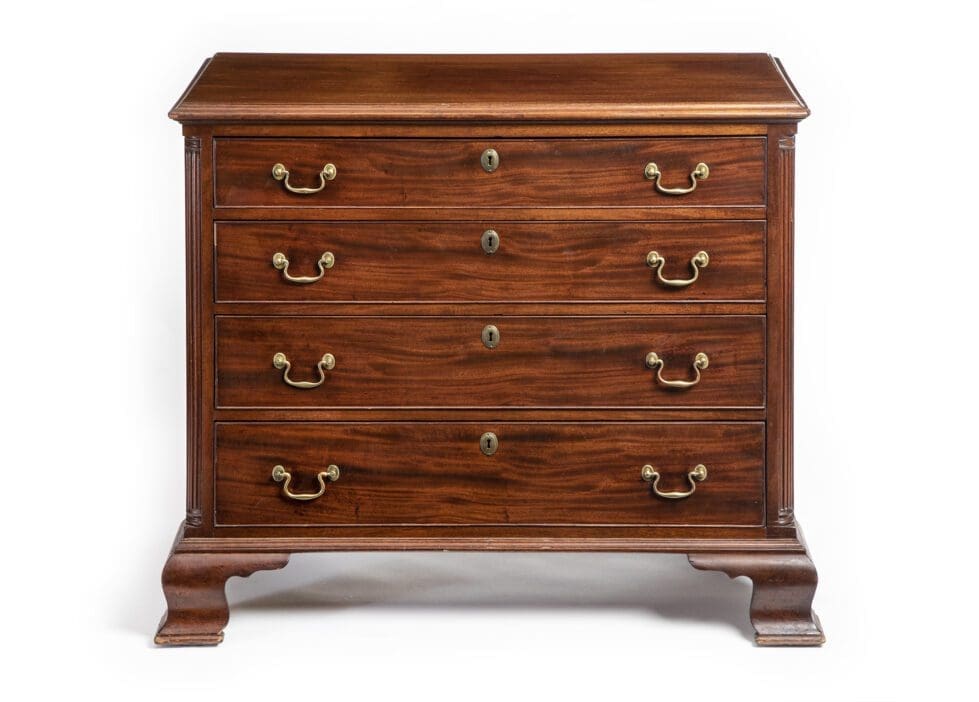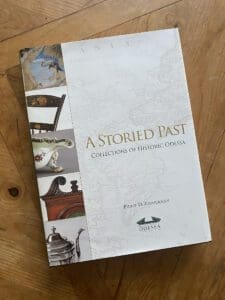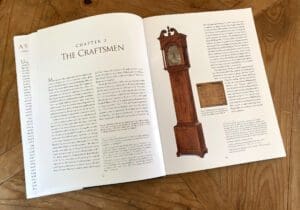
This Delaware-made chest bought at auction sported a tag that said said it belonged to the Corbitt-Sharp House in Historic Odessa. Photo from the Historc Odessa Foundation.
The discovery came via a telephone call.
On the other end of the call, an antiques collector told Deborah Buckson, executive director of the Historic Odessa Foundation, that he’d just bought at auction a chest that had a label on the back that said Corbit-Sharp House.
That’s one of the foundation’s core historic home from Delaware’s Colonial days.
“Do you want to see it,” asked the collector, whom Buckson declines to identify.
“Yes, please,” she said.

Philip D. Zimmerman
The fortuitous purchase turned out to be a four-drawer chest built for the house in 1806 by local furniture maker John Janvier Sr., a craftsman whose skill rivaled any of those in Philadelphia, Buckson said.
Now the chest’s history is detailed in “A Storied Past: Collections of Historic Odessa,” a new book that looks at the decorative and fine arts in the foundation’s Corbitt-Sharp and Wilson-Warner homes.
The 1769 Wilson-Warner House in 1923 became Delaware’s first house museum.
Then, H.F. du Pont of Winterthur was still leading the charge on collecting American-made antiques, and other area du Pont homes that became modern cultural touchstones were still inhabited by their owners.
Author Philip D. Zimmerman of Lancaster, Pennsylvania, a national authority on early American furniture, will talk about researching and writing “A Storied Past” before he signs copies of it Thursday, Sept. 21, at 4:30 p.m. at the Foundation at 201 Main Street.
Zimmerman was able to use the foundation’s rich archival and genealogical sources to profile 100 decorative and fine art pieces from the Historic Odessa Foundation’s collections.
The book includes more than 200 photographs, including many detail and historic images, along with careful physical descriptions and historical documentation.
Ultimately, Zimmerman’s work not only illuminates the furnishings, art and artifacts by detailing their provenances and owners, but also places them into their artistic, social and historical contexts of their time.
The historic district in Odessa is a 72-acre enclave of 18th and 19th century structures, two miles from Route 1 and just off U.S. Route 13 in southern New Castle County.
The book details only a fraction of the 7,000 objects and furnishings from Delaware’s colonial period in an area originally known as Cantwell’s Bridge. It’s listed on the National Register of Historic Places and home to a National Historic Landmark and two National Park Service Network to Freedom sites.
A second Odessa chest
The story of the Janvier chest continues in the book.
Zimmerman was able to authenticate the chest, thanks to previous research and meticulous records that the foundation owns.
“The Corbits were very early collectors,” Buckson said. The chest had been listed in an 1818 family inventory.
“That was extraordinary for the time, because this is a young country,” she said. “People are just building their lives, this country is growing in its early stages, and you have this family that are interested in preserving their family history, which is some of the earliest collecting that you can find.”
MORE ARTS/CULTURE: Rossetti exhibit moves from London to Wilmington in October
She and Zimmerman were looking at John A.H. Sweeney’s 1959 book, “Grandeur on the Appoquinimink: The House of William Corbitt at Odessa, Delaware,” when they spotted another Janvier chest that looked just like the newly discovered one. Sweeney said in his book who owned it.
“So you suppose we could find that person,” Zimmerman asked.
“I know exactly who to call,” Buckson told him.
She called one of the family’s descendants and asked if she would happen to know where the chest of drawers was.
“I do,” the woman told her. “It’s in my bedroom.”
The owner invited Buckson and Zimmerman to come see it. Before they got there, she emptied everything out of it.
“We studied it,” Buckson said. “We took the drawers out. We looked at it with lights. We turned it over. And, low and behold, there as signature of John Janvier engraved on the bottom.”
“Well,” the owner said, “you must have it because it’s a pair. So the chest that was saved at an auction and the chest of drawers that was still in the family were a matched pair.
“There’s probably less than a dozen pairs of chests in the country. Now they’re both back together, living very happily at the Corbit-Sharp House.”

Betsy Price is a Wilmington freelance writer who has 40 years of experience, including 15 at The News Journal in Delaware.
Share this Post






